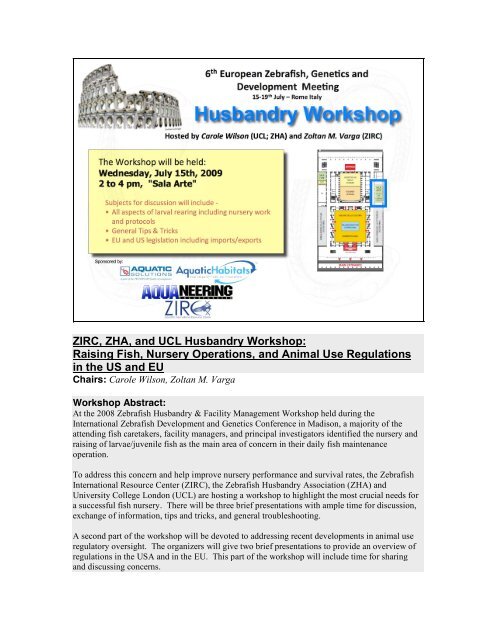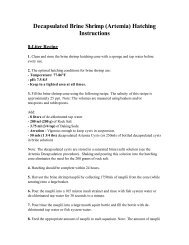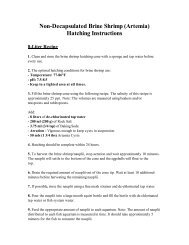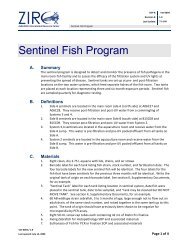Rome Workshop Info 09CW - Zebrafish International Resource Center
Rome Workshop Info 09CW - Zebrafish International Resource Center
Rome Workshop Info 09CW - Zebrafish International Resource Center
You also want an ePaper? Increase the reach of your titles
YUMPU automatically turns print PDFs into web optimized ePapers that Google loves.
ZIRC, ZHA, and UCL Husbandry <strong>Workshop</strong>:Raising Fish, Nursery Operations, and Animal Use Regulationsin the US and EUChairs: Carole Wilson, Zoltan M. Varga<strong>Workshop</strong> Abstract:At the 2008 <strong>Zebrafish</strong> Husbandry & Facility Management <strong>Workshop</strong> held during the<strong>International</strong> <strong>Zebrafish</strong> Development and Genetics Conference in Madison, a majority of theattending fish caretakers, facility managers, and principal investigators identified the nursery andraising of larvae/juvenile fish as the main area of concern in their daily fish maintenanceoperation.To address this concern and help improve nursery performance and survival rates, the <strong>Zebrafish</strong><strong>International</strong> <strong>Resource</strong> <strong>Center</strong> (ZIRC), the <strong>Zebrafish</strong> Husbandry Association (ZHA) andUniversity College London (UCL) are hosting a workshop to highlight the most crucial needs fora successful fish nursery. There will be three brief presentations with ample time for discussion,exchange of information, tips and tricks, and general troubleshooting.A second part of the workshop will be devoted to addressing recent developments in animal useregulatory oversight. The organizers will give two brief presentations to provide an overview ofregulations in the USA and in the EU. This part of the workshop will include time for sharingand discussing concerns.
<strong>Workshop</strong> Overview:Part 11) Fish Breeding in MilanFederica PezzimentiCogentech, IFOM-IEO Campus, Via Adamello 16, Milan, Italy2) <strong>Zebrafish</strong> Larval Rearing at UCLJenna Lea HakkesteegUCL Fish Facility, University of London, UK3) The ZIRC Nursery and Grow-Out SectionCarrie Barton<strong>Zebrafish</strong> <strong>International</strong> <strong>Resource</strong> <strong>Center</strong>, University of Oregon, Eugene, USA30-minute discussion, moderated by Carole and/or ZoltanPart 24) EU Legislation for Fish Husbandry and ShippingCarole Wilson,UCL Fish Facility, University of London, UK5) US Legislation for Fish Husbandry and ShippingZoltan M. Varga<strong>Zebrafish</strong> <strong>International</strong> <strong>Resource</strong> <strong>Center</strong>, University of Oregon, Eugene, USA10-minute discussion, moderated by Carole and/or Zoltan
Abstracts/Presentations:Part 1 Presentations: Raising Fish & Nursery Operations(Each 10 minutes max)1) Fish Breeding in MilanFederica PezzimentiCogentech, IFOM-IEO Campus, Via Adamello 16, Milan, ItalyIn this presentation, I will explain my experience in breeding and maintenance of zebrafish larvae atthe Ifom-IEO-Campus of Milan.To develop our method of rearing, I tried different types of dry food for larvae and several providersof artemia. Initially, the larval diet included also paramecia, but I recently found these not to benecessary. I have devised a way to clean the nursery tanks from excess food and set up a schedulefor feeding and cleaning that results in a 70% survival rate. Moreover, I have tried to release them indifferent numbers and feed larvae according to their size and not their age.Now, breeding and the maintenance of zebrafish larvae has been standardized to the level in ourfish facility that we have homogeneous size and high rates of survival to adulthood.2) <strong>Zebrafish</strong> Larval Rearing at UCLJenna Lea HakkesteegUCL Fish Facility, Division of Biosciences, University of London, Gower Street,London, WC1E 6BT, UKThis presentation is aimed to show how zebrafish larvae are successfully raised at UCL accordingto standardized protocols. In order to achieve the best survival rates various methods have beenimplied such as feeding appropriately according to their size and increasing water flow ratesaccordingly as well as keeping a good paramecium culture and following protocols for the decapsulationof brine shrimp cysts. From a trial where three different types of popular diets forraising fry - dry, live, and a combination of both - were compared, it was found that thecombination diet produced higher survival rates as well as a much faster increase in body mass.Owing to the combination diet and protocols followed, we currently have survival rates of 85%.3) The ZIRC Nursery and Grow-Out SectionCarrie Barton<strong>Zebrafish</strong> <strong>International</strong> <strong>Resource</strong> <strong>Center</strong>, 5274 University of Oregon, Eugene, OR 97404,USAOur goal is to optimize the throughput, survival, growth rate, and health of zebrafish. Byadapting optimal and cost-efficient husbandry methods, we improved the efficiency, speed, andsuccess of growing zebrafish at ZIRC. Thus, the nursery and larval grow-out sections contributesignificantly to the turnover of fish generations at the <strong>Resource</strong> <strong>Center</strong>.At the ZIRC, we use age- and size-specific powdered dry food as well as live food, such asparamecia, and artemia. We also incorporated the use of a modified E2 embryo medium inwhich embryos/larvae are maintained before transfer to the nursery. In the nursery and grow-outsections, we developed feeding schedules, optimized water flow times and flow rates, and westreamlined the general workflow for rearing zebrafish. Because our zebrafish larvae are given





